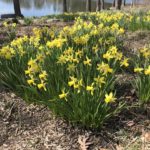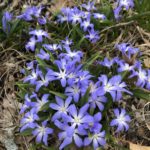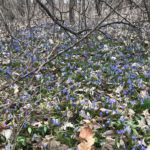Spring is the time for feel good color and here’s a simple way to make plants work for you!
How genius to use the unused space under and around your shrubs to plant carpets of spring flowers. To make sure it’s super easy and low care I’m recommending bulbs and early spring perennials that naturalize, which is a fancy way of saying they will spread all on their own to create beautiful drifts of color to enjoy for years to come. Which seems like magic but really it’s only taking advantage of what these magical plants want to do naturally! The only effort you need to make is obtaining the plants and planting them. And, of course, taking credit for being so smart!
Since hydrangeas are so popular these days I’ll use them as the shrub example. Say you have a group of three hydrangeas. Which basically looks like a bunch sticks until leaves appear in May. So right there you have an ideal spot to add something that will perk up your view in April when we are all craving a perk up. Simply plant a carpet of these early bloomers between and around the hydrangeas and enjoy!
The Blues – Glory in the snow (Chionodoxa) & Siberian squill (Scilla siberica)
These are both tiny bulbs that bloom in early spring. Spreading by seed as well as producing offsets (a fancy word for baby bulb) these will, over time, fill an area. To start out with the best impact I recommend planting generous amounts. You can order them in bulk from Van Engelen and when they arrive in the fall simply plant about 20-25 of them closely in several shallow holes, 2-3″ deep, no need to worry about anything technical like proper spacing.
Daffodils (Narcissus)
The familiar yellow flowers that hardly need an introduction. They are bright and eye catching and absolutely dependable. While there are an amazing amount of varieties available, for early blooming my go-to is ‘Jetfire’, again, Van Engelen carries it. This variety is a little shorter than some of the others and naturalizes well. Plant it generously, and know that within a few year years you can rely on ultra impressive drifts of cheery, care-free yellow in early spring. Again, closely planting at least a dozen per hole will give tight clumps like those in photo above and make simple work of the digging and planting part. Just bury them 6″ deep and you’re set.
Bloodroot (Sanguinaria canadensis)
Intriguing name for a great native plant that deserves to be more widely known and used. I can remember my Grandma teaching me about this plant, picking one to break it’s stem to show me the orangey “blood” inside. And then making sure I knew they’re special and not to pick them myself!
The blooms are sparkling white and open on sunny days to attract your attention. It is an important spring plant for bees, perfect for adding beneficial insects to your garden. It’s an ephemeral plant, which means it has adapted to woodland conditions by blooming early in the spring before the trees leaf out and then disappears by midsummer. It’s a little harder to find but well worth searching for. I’d recommend going to a native plant sale to seek it out, although you may luck into it at a specialized local or online nursery. If you know someone who has it growing in their yard they may share some with you, but please don’t dig it from the woods, that’s not exactly good citizen or generous gardener behavior.
These flowers are only four options that can stretch your imagination about what to plant and where to maximize your enjoyment this spring. Using colorful low-maintenance spring blooming plants as groundcover to “double duty” your planting space is a genius way to get more from your garden.
To learn more about great plants, easy to care for gardening or how to work with me click here.





